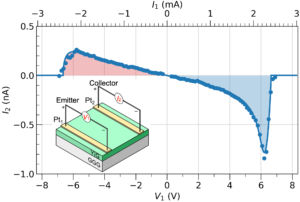
Ryuhei.KOHNO
Wednesday February 15th, 2023 at 14:00 in auditorium 445 Bat. 10.05 CEA Grenoble, Ryuhei Kohno from SPINTEC will defend his PhD thesis entitled :
Non-local magnon transconductance in extended magnetic insulating films
Access : to room 445 needs CEA pass contact admin.spintec@cea.fr sufficiently early (before February 05th).
Zoom link : https://cnrs.zoom.us/j/94292021385?pwd=RUhtelRzdkd6akpwcWNLN09EcTFFUT09
Meeting ID: 942 9202 1385
Passcode: 2EkfYD
Abstract : Diodes are key components in electronics. Their prized property is to provide non-linear behavior such as asymmetric conductance which allows the transport in the forward direction while blocking it in the reverse. This feature is exploited in more complex structures such as the transistor. Recently it was thought that the same feature could occur in magnetic materials by electrically shifting the magnon chemical potential towards the energy band minimum. Highly non-linear behaviors were predicted for a bosonic system prone to Bose-Einstein condensation. In this field the highest benchmarks are expected to be obtained with magnetic insulators, which have the lowest magnetic damping. The damping is the fundamental factor that moves the chemical potential as a function of an electrical signal.

Asymmetric I-V characteristics produced by pure spin currents propagating inside an extended insulating magnetic film: the spin diode effect. The inset is a schematic of the non-local device, where magnons are electrically emitted or absorbed in the dielectric film by spin transfer effects via two YIG|Pt electrodes.
Using non-local devices, we have performed a comprehensive study of the nonlinear transport properties of magnons, which are electrically emitted or absorbed inside extended YIG films by spin transfer effects via a YIG|Pt interface (see figure). In this thesis, we reveal that the low-energy magnons which provide the spin-diode effect are competing with a featureless background of high-energy magnons. We will show however that there are several ways to make the low-energy magnons dominant. Doing that, we did not find evidence of a strong spin diode effect expressing a diverging increase of the magnon density. We observe instead a condensation limited by an enhancement of magnon-magnon relaxation rate, which caps the occupation of each mode below a saturation threshold. In other words, the reported nonlocal transport signal hints at coupled dynamics between numerous modes rather than the picture of a single dominant mode.
Interestingly, we notice similarities between these magnon transport properties with electron conduction in ultra-clean systems that show hydrodynamic behavior. In addition, we noticed the role of the phonons in the transport of angular momentum. As future research direction, we propose the search for direct evidence of magnon hydrodynamics behavior and a better understanding of the roles of phonons in providing long-range spin transport.
Titre français : Tansconductance non locale de magnon dans des couches d’isolants magnétiques étendues
Résumé : Les diodes sont des composants clés de l’électronique. Leur propriété est de présenter un comportement non linéaire tel que la conductance asymétrique qui permet le transport dans le sens direct tout en le bloquant dans le sens inverse. Cette caractéristique est exploitée dans des structures plus complexes telles que le transistor. Récemment, il a été pensé que la même caractéristique pourrait se produire dans les matériaux magnétiques en déplaçant électriquement le potentiel chimique des magnons vers le minimum de la bande d’énergie. Des comportements hautement non linéaires ont été prédits pour un système bosonique sujet à la condensation de Bose-Einstein. Dans ce domaine, les meilleurs résultats devraient être obtenus avec les isolants magnétiques, qui présentent l’amortissement magnétique le plus faible. L’amortissement est le facteur fondamental qui déplace le potentiel chimique en fonction d’un signal électrique.
En utilisant des dispositifs non locaux, nous avons réalisé une étude complète des propriétés de transport non linéaires des magnons, qui sont électriquement émis ou absorbés à l’intérieur de films YIG étendus par des effets de transfert de spin via une interface YIG|Pt (voir figure). Dans cette thèse, nous révélons que les magnons à basse énergie qui fournissent l’effet de diode de spin sont en concurrence avec magnons à haute énergie sans caractéristiques. Nous montrerons cependant qu’il existe plusieurs façons de rendre les magnons de basse énergie dominants. Ce faisant, nous n’avons pas trouvé la preuve d’un fort effet de diode de spin exprimant une augmentation divergente de la densité de magnons. Nous observons plutôt une condensation limitée par une augmentation du taux de relaxation magnon-magnon, qui plafonne l’occupation de chaque mode sous un seuil de saturation. En d’autres termes, le signal de transport non local rapporté suggère une dynamique couplée entre de nombreux modes plutôt que la répresentation d’un seul mode dominant.
Il est intéressant de noter les similitudes entre les propriétés de transport des magnons et la conduction des électrons dans les systèmes ultra-propres qui présentent un comportement hydrodynamique. En outre, nous avons remarqué le rôle des phonons dans le transport du moment cinétique. Comme future direction de recherche, nous proposons la recherche de preuves directes du comportement hydrodynamique des magnons et une meilleure compréhension des rôles des phonons dans le transport du spin à longue distance.
Jury members :
- Dr. Catherine Gourdon – Directrice de Recherche, CNRS, Institut des Nanosciences de Paris, Sorbonne Université
- Prof. Dr. Sebastian T.B. Goennenwein – Professeur, University of Konstanz
- Prof. Dr. Jean-Philippe Attané – Professeur, CEA, CNRS, Spintec, Université Grenoble Alpes
- Dr. André Thiaville – Directeur de Recherche, CNRS, Laboratoire de Physique des Solides, Université Paris-Saclay
- Prof. Dr. Yoshichika Otani – Professeur, Institue for Solide State Physics, University of Tokyo & Center for Emergent Matter Science, RIKEN




